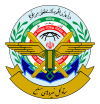Zelzal-3
This article needs additional citations for verification. (November 2009) |
| Zelzal-3 | |
|---|---|
 Zelzal-3 in 2009 | |
| Type | Artillery rocket |
| Service history | |
| In service | 2007–present |
| Used by | |
| Wars | Yemeni Civil War (2015–present) Saudi Arabian-led intervention in Yemen |
| Production history | |
| Manufacturer | Iran |
| Specifications | |
| Mass | 3.6–3.87 tonnes depending on model. |
| Length | 9–9.6 m depending on model |
| Diameter | 610 mm |
| Warhead | One |
| Engine | Solid |
Operational range | 250–400 km depending on model[1][2] |
Guidance system | Inertial plus GPS[3] |
Launch platform | Transporter erector launcher |
Zelzal-3 (Template:Lang-fa, meaning "earthquake") is an Iranian-made solid propellant guided artillery rocket with a range of 200 km.[4] It is an upgrade of the Zelzal-2 rocket with slightly improved range and was first shown to the public in 2007. A variant, the Zelzal-3B, has a smaller warhead and a range of 250 km.[2] The shape and dimensions of the Zelzal-3 are nearly identical with previous versions except that the nosecone is cone shaped rather than the dome shaped Zelzal-2 and Zelzal-1. The Zelzal-3 has received little use as the much more accurate Fateh-110 missile was also developed from the Zelzal-2.
A number of sources confuse the Zelzal-3 with the Shahab-3 ballistic missile.

Operators

Houthis have a rocket they call the Zelzal-3, which they claim it is locally-made and not imported from Iran.[6]
See also
- Zelzal-1
- Zelzal-2
- Fateh-110
- Military of Iran
- Iran's missile forces
- Iranian military industry
- Current Equipment of the Iranian Army
References
- ^ a b "Modlex product: MXF05-000360 Zelzal 3 Surface to Surface Rocket". Modlex.ir. Archived from the original on 2012-09-08. Retrieved 2013-09-03.
- ^ a b c "Modlex product: MXF05-000370 Zelzal 3-B Surface to Surface Rocket". Modlex.ir. Archived from the original on 2013-07-29. Retrieved 2013-09-03.
- ^ Iran Rocket Missile forces amazonaws.com
- ^ Cordesman, Anthony H. (2007). Lessons of the 2006 Israeli-Hezbollah War. p. 11. ISBN 978-0-89206-505-9.
- ^ "Defense & Security Intelligence & Analysis: IHS Jane's | IHS". Articles.janes.com. Archived from the original on 2012-07-07. Retrieved 2013-09-03.
- ^ Analysis: IRGC implicated in arming Yemeni Houthis with rockets

